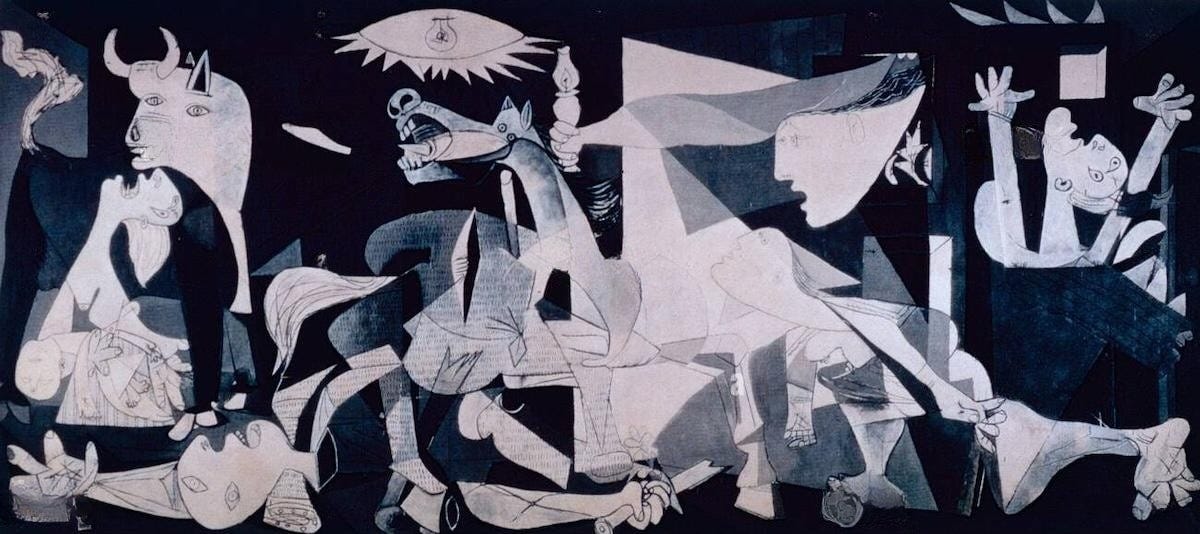Truth Isn't Subjective, But We Subject It To Us
An Experiment and Some Wild Speculation On the Subjective Nature of Experience
A Little Experiment
Let’s try a wild experiment.
Here is a video of a man saying, “Parker get out of the tank.”
Did you hear it? Did you hear “Parker” clearly and distinctly?
Now listen to this man say: “Arthur, get out of the tank.”
Did you hear the man shout “Arthur” clearly and distinctly in this video?
Well, these were both the same video.
What you hear, as I noted when I came across this video several years ago, depends upon what you expect to hear. You hear what you want to hear.
This isn’t to say that an objective reality doesn’t exist.
I’m not that postmodern.
On the contrary, reality is so true, and truth’s light is so bright that it always requires filtering to be comprehended by the weakness of our minds as this poem by Emily Dickinson that I’ve long appreciated suggests:
Tell all the truth but tell it slant —
Success in Circuit lies
Too bright for our infirm Delight
The Truth's superb surprise
As Lightning to the Children eased
With explanation kind
The Truth must dazzle gradually
Or every man be blind —— Emily Dickinson
Subjectivity and Truth
Truth is true and yet is encountered by persons who themselves are subjects. Therefore, our encounter with truth will be subjective because we ourselves are subjects who bring differing desires, differing experiences, and differing limitations to our encounters with external reality. We focus upon different aspects of reality when we each individually encounter it. Some of us do it better than others. There is a possibility of error. And yet, since the very concept of “error” implies its contrary, we have to say that even if truth is “filtered” by our subjective personalities, it is, contrary to the extreme skepticism of Descartes, truly encountered.
Even as our knowledge is distinct from the reality of objects existing in re, in themselves, there is a real relationship between the two, and that relationship is our personality as I believe the Catholic phenomenological tradition of St. Teresa Benedicta of the Cross best expounds.
Just as within the Church, Divine Revelation such as Scripture and the teachings of the Apostles’ requires a continuing Magisterium to expound, interpret, and defend it, so also does natural revelation coming from our sense experience of the world require a filtering process, or what I call a world model which we use in our mind/intellect (it is a process likely involving both and which can be neither merely material nor immaterial) to come to truth as I wrote more about last year here:
Bacon's Idols Aren't All That Bad After All
We are not objective observers separate from reality but are part of the very reality that we observe. We can only sense things in relationship to ourselves. We are subjects because we must always observe the world from one particular point at one particular time, with a particular past leading up to that moment and a particular state of mind, emotions,…
Experience is a Recreative Process
Even though I disagree with the recent neo-Kantian philosopher Donald Hoffman on many things, his idea of experience—and knowledge—as a recreative process seems apt as I summarized last year:
We attempt to construct (or reconstruct) a representation or reality within our mind by carefully applying rules to the phantasms (raw sense inputs) we receive from without to come to one true accurate representation out of the many possible ambiguous representations of the “raw data” coming from each sense.
What someone objectively receives from their senses, simple objective phantasms of sense, is combined with the subjective framework they have inherited or themselves built up to produce the experience experienced:
Objective Reality + Subjective Framework = Experience
Phantasms from Proper Sense Objects + Interpretive Lens = Content You Receive
Thus two physically identical sets of sense experiences could have different content or produce different experiences in two different viewers because of the differing interpretive lenses or alternatively phrased background frameworks or subjective frameworks, of the viewers.1
Returning to the above videos, what’s happening is the same as would be the case with every other video or any other time we listen to things in the world. There is an objective sound being made an objective sound or a word that the speaker intended to say. However, that one particular sound waveform is not experienced in a raw manner but filtered or processed according to what we subjectively expect to hear. And this should be obvious to us already in other ways. In a language that you know, unless you’re singing, we rarely pay attention to what the words “sound” like. We jump instantly through the filtering or “recreating” work of our world model to the “words” as concepts, to the things signified by the sounds. In a language we don’t understand, however, we hear the sounds first and then have to put in the effort of mapping these sounds onto words, and then on to concepts and images. In both cases, we do the same thing, but in the former, we usually ignore or don’t notice our recreative activity at work because of how quick and efficient it is.
These video examples are just cases where the sound is ambiguous enough that we don’t all necessarily run through the process in the same way as each other, or the same way every time. Perhaps, if we were to listen more carefully or with more context, we would come to a perfect and consistent answer. Consistency, of course, is required in the nature of truth. Inconsistency happens when either a grasp of truth is imperfect or only certain aspects of truth are focused on at a time.
Technically, any time we are not in the beatific vision, we see imperfectly, as St. Paul reminds us of spiritually, but which I believe applies to all knowledge:
For now we see in a mirror dimly, but then face to face. Now I know in part; then I shall understand fully, even as I have been fully understood. — 1 Corinthians 13:12
As we do not see the truly interconnected nature of all things through their cause in God, we are not now fully in possession of all truth. This does not mean that we know no truth, but merely that, as with St. Paul, we see “dimly” or “in part.”
I might listen to a song, for example, and come to understand certain aspects, like the intervals or chords, while another person focuses on the instruments used, another on the rhythm, etc. Each of us has only a partial grasp of the truth concerning the song, but none of us are without truth about it entirely.
But let’s take this qualified idea of subjectivity or a filtering, recreative process being involved in our understanding further—and in a weirder direction.
Our Visual Sense Experience Has Changed
Renaissance Perspective
Before Fillipo Brunelleschi developed the process of linear perspective painting around 1420 and Leon Battista Alberti codified and figured out how to explain it to other artists later in the century, there were few if any real examples of perspective in painting.
Perspective painting, although omnipresent today, is highly technical and difficult to do right. It requires picking a certain imaginary vantage point for your picture (i.e., are you looking at the scene from normal human height, or are you near ground level?) as well as a strong geometric ability to calculate the relative sizes of objects to make the painted effect imitatively represent your imaginary scene.
Compare an early 14th-century painting of the Italian city of Florence to one from later in the next century as Samuel Edgerton does in The Renaissance Rediscovery of Linear Perspective with the two paintings displayed above, and a stark difference between the two is obvious.
The first painting has a quality and an approach characteristic of Byzantine icons or stained glass windows. Put simply, it’s flat. The buildings are bunched together, arranged in an order within the image that does not directly correspond to their visual and spatial arrangement within reality. We see, for example, too many sides of many of the buildings at once, more than we could ever visually see at one moment in time. Furthermore, objects that we, accustomed to perspective, would expect to be more distant and smaller due to their location at the top of the image, are really much the same size as those anywhere else within the painting. The painting then, is of Florence, but without trying to be of Florence as seen from any one particular point, but Florence as it is experienced as a whole, emphasizing not accuracy in the representation of spatial detail, but of the relationship between parts and whole.
The second, by contrast, is more like what we are used to seeing in paintings (and more frequently) photographs. The image, through its use of the perfected perspective technique, is meant to represent Florence as perceived from one particular point in the distance outside of it, and only from that point. Details that we can’t see from that one particular point aren’t shown, but we see incredible detail and perfect arrangement of the shapes and colors that we would see from that one point in space at one point in time.
Visual World vs. Visual Field
Following Samuel Edgerton2 I’d contrast the pre-Renaissance (without perspective) and post-Renaissance (with perspective) approaches as aiming at two different types of representing the world:
Visual world: The world as experienced by all the senses taken together.
Visual field: The world as experienced by sight alone from one particular vantage point.
The first approach depicts objects as they would be perceived by all the senses across all of one's experiences of them. The order between objects is hierarchical and conceptual rather than spatial, and there is no attempt at visual perspective representation. Objects and beings in their complete totality, or perhaps, inner essence, are the primary subjects of representation. In the second, however, space is emphasized above objects and beings, and the external characteristics of a being, especially sight alone, and sight from one vantage point alone are emphasized.
We Actually See Differently Now
Now, this could seem to be merely a change in artistic technique and the purpose of art in different eras. Yet, Edgerton argues (and I concur) that this change in art accompanied a very real difference between how the medievals perceived and processed reality compared with how later men became accustomed to doing so.
In The Mirror, the Window, and the Telescope, Edgerton argues that the development of linear perspective, alongside the work of Descartes and Galileo created a change in man’s habits (or at least in most men) from making “objects” the primary foci of attention to (quantifiable) “appearances.” Descartes’ radical skepticism and newfound locus of certainty in the “I” rather than the world led everyone sense to take “perspective”, “place”, and “individuality” as far more important than most did before him. Ever since we have all “Cartesianized” and “relativized” our imaginations, and through that our experiences. We experience space differently than those before. We see things through space in a way that makes us constantly conscious of our own current location in space relative to them, a way of seeing that relativizes and subjectifies our experience of their visual accidents.
For us, visual perspective as perceived by one person from one point in space and one point in time is not just a technique that has been perfected in painting and photography, but the way in which we perceive reality. We mostly ignore beings as beings and focus on their external characteristics.
An easy experiment to demonstrate this is to walk onto the main street of a midsized city (or any place where you can look at a variety of buildings of different shapes and sizes). Look at them without effort. Then look again, and try to focus on the fact that they are three-dimensional buildings with depth, heft, and substance. The second view, perceiving objects as objects, is not habitually easy for us anymore. The second view is the old view, the pre-Renaissance, pre-linear-perspective view. It’s counter-intuitive, but perspective even though it allows us to represent three-dimensional objects in their three-dimensionality upon a two-dimensional surface makes us less aware of their three-dimensionality or of them as objects. The colors, the edges, and the flashy details impress us, but we lose sight of the object beneath. Or at least temporarily. We can, barely, regain the old view, but it takes effort and an additional step.
And we’re partially justified in our new way of looking at things. The Cartesian approach of focusing on external characteristics and looking for patterns allows us to know details about the external characteristics of objects far better than ever before in history. We can calculate the movement of the stars or the exact measurable energy states of the outcome of chemical reactions or particle collisions with immense precision. Clarity about anything that can be turned into a “number” is far better for the shift in attention from beings and objects to characteristics and quantities.
But the shift is a shift. Both “perspectives” are true and yet the newfound clarity on certain details leaves us ever more unsure of what the beings whose external characteristics we understand with clarity even are in themselves. In everyday life, we are so overwhelmed by perspective art and photographs that we lose sight of the old view and we never stop to pay attention to the objects around us as objects.
We literally, I believe, see the world differently when we look out into it than the average man in the 14th century would have. Yes, his eyes were working, and yes ours are as well, but we are processing the world with a different agenda and with different priorities in mind.3 This is not to say that one perspective is more true but that the external reality is being filtered through subjects with different priorities and these priorities are reflected in our differing experiences.
Edgerton is in fact proposing historically that the development of linear perspective in art helped prompt the change in how we see, and not vice versa. Bernardo Daddi in 1342 didn’t just avoid drawing Florence in linear perspective because he didn’t know how to represent what he saw with his eyes. Rather he drew Florence, the way he saw, or perhaps more properly experienced it as a whole.
Men experienced the world back then more as a combined experience of all of their senses combined with past memories together aiming at objects as objects, whereas now, with linear perspective paintings filling our imaginations, we are more and more disposed to focus on the appearances of objects to sight alone and to the externals of said objects above all. We focus on, and are ever aware of, the shifting and limited appearances of a thing and recognize less and less the solidity and unification of objects as objects, having some unity and extension beyond what is made apparent from one vantage point.4 For 20th-century Canadian philosopher Marshall McLuhan, who shares some of Edgerton’s views here, while much of the so-called modern world has in lock step habituated itself to this change, he proposes that Africans in Africa, at least in the 1960s retained much of the old ways and habits of seeing.
It is a real question as to which experience of the world should be conveyed by visual art as trends within the last century have, in many ways, gone backward and removed linear perspective as a priority in favor of something else.

What Else Is Mutable?
Let’s take this one step weirder before I close. St. Augustine remarked once in his Confessions, that St. Ambrose had a unique ability to read silently. For most of us, this is so normal that we prefer it to reading aloud. Augustine’s remark seems to imply that it was so rare as to be thought impossible, or at least was abnormal to do in his time. One likely interpretation is that humans have developed a new habit of mind for relating visible characters or blocks of them together directly to imaginative or intellectual concepts rather than passing them through an intermediary of sound as spoken speech. Perhaps almost no one in Augustine’s time read aloud because they never even noticed that they could directly relate visible symbols and concepts, so focused as they were on other things, which we, humbling ourselves, should admit that they might have been able to see, or hear better than ourselves.
What else might we not be seeing? What else might we be filtering out and not letting ourselves see, hear, feel, or otherwise “sense”? I think it’s quite a lot. Our sense experience today is quite different from that of someone living in the 14th century or before the birth of Christ. Personal experiences from my own life involving space, time, and objects “appearing” to relate differently to each other are manifest whenever I leave the quotidian habits of modernity, as in numerous solo backpacking trips (including at night) I’ve taken as well as extended visits I’ve made to Benedictine monasteries as
of also points out here and here and which also to a degree is the whole point of his publication. More on my own experiences on what we’ve “filtered out” from our quotidian approach to reality to come.The guiding principle should remain that even though subjectivity is everywhere, and its effects are absolutely massive, it doesn’t destroy objective truth being out there and available to us. Truth isn’t subjective, but we subject it to us. And we happen to be “subjects” after all.
Bacon's Idols Aren't All That Bad After All
We are not objective observers separate from reality but are part of the very reality that we observe. We can only sense things in relationship to ourselves. We are subjects because we must always observe the world from one particular point at one particular time, with a particular past leading up to that moment and a particular state of mind, emotions,…
Canadian philosopher Marshall McLuhan creates a similar dichotomy between two types of representation:
The visual power enables us to isolate the single incident in time and space, as in representational art. In visual representation of a person or an object, a single phase or moment or aspect is separated from the multitude of known and felt phases, moments or aspects of the person or object. By contrast, iconographic art uses the eye as we use our hand in seeking to create an inclusive image, made up of many moments, phases, and aspects of the person or thing, Thus the iconic mode is not visual representation, nor the specialization of visual stress as defined by viewing from a specific position. The tactual mode of perceiving is sudden but not specialist. It is total, synesthetic, involving all the senses.
Donald Hoffman’s Visual Intelligence, a kind of Euclid’s Elements for how we process visual sense data is something I hope to write more about soon. His work offers when combined with Edgerton’s quite interesting possibilities for how our shift in sight has occurred.
An Aristotelian perspective on the change is that the “common” or unifying sense that aggregates sense data from all the senses has atrophied since antiquity, or at least we habitually use it differently than they used it.









I probably spend WAY too much time thinking about epistemology (especially in the context of politics these days). We need to have opinions and we need to treat some of them as if they're almost certain... but I think it's a good idea to remember that, on ANYTHING, you could be wrong. That attitude enjoins some humility and curiosity, and kindness.
Our biggest political problem isn't polarization-it's the epidemic of self-righteous fury at people who disagree: assigning motivations, bigotry, out-group hostility. Those are the elements that makes our culture more dysfunctional, not varying views on reality.
https://jmpolemic.substack.com/p/scout-mindset